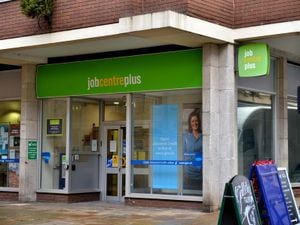Unemployment drops in the West Midlands but pay falls further behind rocketing inflation
Unemployment in the West Midlands fell in the three months to March.

The number out of work in the region was 138,000 – down 9,000 on the previous three months and a fall of 39,000 for the year.
Over the year employment in the West Midlands has risen by 126,000 to 2.86 million.
Britain's jobless rate has fallen to its lowest level for over 47 years but workers have seen their pay fall further behind rocketing inflation, according to official figures.
The rate of unemployment dropped to 3.7 per cent in the three months to March – the lowest since October to December 1974, the Office for National Statistics said.
The jobs figures showed there were 118,000 fewer jobless Britons at 1.26 million in the quarter to March, while those in employment rose 83,000 to 32.6 million.
For the first time, there were fewer unemployed people than job vacancies, although the fall in the rate – down from 3.8 per cent in the three months to February – was also due to a rise in the number of people dropping out of the jobs market, the figures showed.
Numbers claiming unemployment benefits, including Universal Credit, in the West Midlands also dropped last month.
For the region the claimant total was down 7,556 to 188,294 – 5.1 per cent of the working population.
Shropshire was down 396 to 4,869 (2.5 per cent) with Telford and Wrekin dropping by 372 to 4,318 (3.9 per cent).
The claimant total in Powys was down by 150 at 1,890 (2.5 per cent).
The ONS also laid bare the scale of the mounting cost-of-living crisis, revealing that regular pay excluding bonuses dropped by 2.9 per cent in March when taking Consumer Prices Index inflation into account – the biggest fall since November 2011.
In the three months to February, real regular pay was two per cent lower, the steepest decline since 2013.
It comes in spite of another pick up – of 4.2 per cent – in regular average pay in the quarter.
Pay including bonuses jumped seven per cent and was up 9.9 per cent in March alone as firms ramped up rewards for staff amid a booming jobs market, seen in particular across sectors such as construction and finance.
The latest ONS labour market data also confirmed another rise in the number of UK workers on payrolls, up 121,000 between March and April to 29.5 million.
Darren Morgan, director of economic statistics at the ONS, said the data showed a "mixed picture for the labour market".
He said: "Total employment, while up on the quarter, remains below its pre-pandemic level.
"Since the start of the pandemic, around half a million more people have completely disengaged from the labour market."
He added: "Indeed, with the latest fall in unemployment, to its lowest rate since 1974, there were actually fewer unemployed people than job vacancies for the first time since records began."
Pay has been failing to keep up with inflation for some months, despite strong earnings growth, and official data on Wednesday is expected to show another eye-watering rise in the cost of living – of 9.1 per cent in April – as last month's hike in the energy price cap hits.
The Bank of England warned earlier this month that the cost crunch is set to leave the UK on the brink of recession, forecasting that inflation will peak at over 10 per cent later this year when energy prices soar again.
It is likely to see a reversal in the buoyant jobs market, with the Bank warning that the rate of unemployment will rise back up to around 5.5 per cent.
Chancellor Rishi Sunak said: "I understand that these are anxious times for people, but it's reassuring that fewer people are out of work than was previously feared."
Matthew Percival, Confederation of British Industry director for people and skills, said: "Despite a slowdown in growth this March, the UK's labour market remains red hot with record vacancies and job-to-job moves.
"Firms are struggling under the weight of persistent labour shortages, rising energy prices and soaring inflation which is adding to the cost of doing business. Workers are also struggling, with inflation already 1.2% higher than pay and rising.
“Urgent action is needed to help alleviate the pressure facing businesses and communities across the UK. Putting pounds into the pockets of people facing hardship and stimulating business investment are two actions the Government can take now that will help us to emerge from this crisis."
British Chambers of Commerce head of economics, Suren Thiru, said: “Record jobs vacancies highlight the perilous hiring crunch facing businesses. With rising economic inactivity confirming that the UK workforce is shrinking, labour shortages are likely to persistently drag on UK growth by stifling firms’ ability to operate at full capacity."





